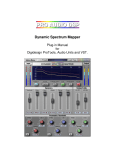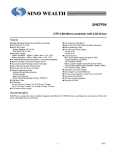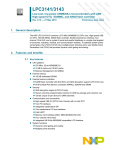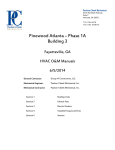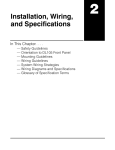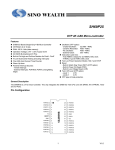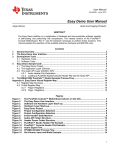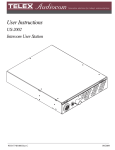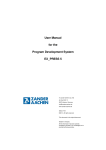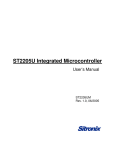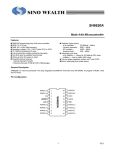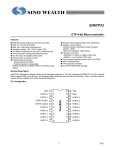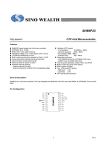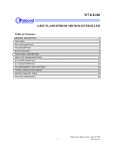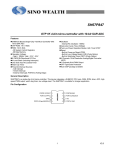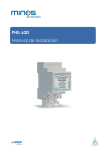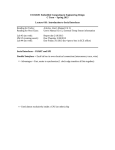Download SH6605
Transcript
SH6605 4K 4-Bit Microcontroller with LCD Driver Features Built-in dual tone PSG with one noise generator 2 Clock sources OSC: (code option select crystal or RC type) - Crystal oscillator 32.768K - RC oscillator: 262K OSCX: (system register selected ceramic or RC type) - Ceramic oscillator 455K - RC oscillator 1.8M or 2M Instruction cycle time: - 122.07µs for 32.768 KHz crystal - 15.27µs for 262 KHz RC - 8.79µs for 455KHz ceramic - 2.22µs for 1.8 MHz RC - 2µs for 2.0 MHz RC Two low power operation modes: HALT and STOP Low power consumption SH6610C-based single-chip 4-bit microcontroller ROM: 4096 X 16 bits RAM: 512 X 4 bits Operation voltage: 2.4V - 6.0V 8 CMOS bi-directional I/O pins 4-Level subroutine nesting (include interrupts) One 8-bit auto re-load timer/counter Warm-up timer for power-on reset Powerful interrupt sources: - External interrupts ( INT0 ) - Internal interrupt (Timer0) - Internal interrupt (Base Timer) - Port's falling edge interrupt: PORTB ( INT1 ) 8-bit Base timer LCD driver: 136 dots (1/4 duty 1/3 bias) LCD used as scan output General Description SH6605 is a single chip microcontroller integrated with SRAM, timer and dual-tone PSG, LCD driver, and I/O port. This chip includes a built-in a dual-oscillator to enhance the total chip performance. 1 V2.0 SH6605 Pad Configuration S E G 2 0 S E G 2 1 S E G 2 2 S E G 2 3 S E G 2 4 S E G 2 5 S E G 2 6 S E G 2 7 S E G 2 8 S E G 2 9 S E G 3 0 53 52 51 50 49 48 47 46 45 44 43 S E G 3 2 S E G 3 1 S E G 3 3 SEG 19 54 SEG 18 1 39 SEG34 SEG 17 2 38 COM 4 SEG 16 3 37 COM 3 SEG 15 4 36 COM 2 SEG 14 5 35 COM 1 SEG 13 6 34 OSC1 SEG 12 7 SEG 11 8 42 41 SH6605 40 33 GND OSC0 PORTC0 32 SEG 10 9 31 OSCXO SEG 9 10 30 OSCXI SEG 8 11 VDD 29 PORTA0 SEG 7 12 21 28 PORTA1 27 PORTA2 13 14 S E G 6 S E G 5 15 S E G 4 16 17 18 19 20 S E G 3 S E G 2 S E G 1 P T E S T P R E S E T B 22 23 24 P O R T B 3 P O R T B 2 P O R T B 1 P O R T C 1 25 26 P O R T B 0 P O R T A 3 Block Diagram ROM (4096 X 16) RAM (512 X 4) OSCS SH6610C 8-BIT TIMER0 CPU CORE PORTB PORTB [0:3] PORTA & EXTERNAL INT COMMON LCD RESET DRIVER RAM SEGMENT DRIVER PSG SCAN REGISTER GND OSCI OSCO OSCXI OSCXO CPU OPERATING VOLTAGE LCD VOLTAGE GENERATOR 2 PA.1 (PSG) PA.0 (INT0 ) PA.2 (PSG) PA.3 COM [1:4] SEG [1:34] SH6605 Pad Description Pad No. Designation I/O Description 1 - 18, 39 - 54 SEG1 - SEG34 O Segment signal output for LCD display; seg1-seg30 can be shared with scan output 19 TEST I Test pin (Internal pull-low). No connection for user 20 RESET I Reset input (No internal pull-up) 21 VDD P Power supply 22 - 25 Port B.3 - Port B.0 I/O Bit programmable I/O, Vector interrupt ( INT1 ) 26 - 29 Port A.3 - Port A.0 I/O Bit programmable I/O, PA.0 shared with INT0 PA.1, PA.2shared with PSG output 30 OSCXI I Oscillator X input 31 OSCXO O Oscillator X output 32 GND P Ground 33 OSCO O Oscillator output 34 OSCI I Oscillator input 35 - 38 COM1 - COM4 O Common signal output for LCD display 3 SH6605 Functional Description 1. CPU The CPU core contains the following function blocks: Program Counter, ALU, Carry Flag, Accumulator, Table Branch Register (TBR), Data Pointer (INX, DPH, DPM and DPL), and Stack. Decimal adjustment for addition/subtraction (DAA, DAS), Logic operations (AND, EOR, OR, ANDI, EORI, ORI) Decision (BA0, BA1, BA2, BA3, BAZ, BC) The Carry Flag (CY) holds the arithmetic operation ALU overflow. During interrupt or call instruction, carry is pushed into stack and restored from stack by RTNI. It is unaffected by an RTNW instruction. 1.1. PC (Program Counter) The PC is used for ROM addressing consisting of 12-bits: Page Register (PC11), and Ripple Carry Counter (PC10 PC0). The program counter normally increases by one (+1) with each execution of an instruction except in the following cases: (1) When executing a jump instruction (such as JMP, BA0, BC), (2) When executing a subroutine call instruction (CALL), (3) When an interrupt occurs, (4) When the chip is at INITIAL RESET. The program counter is loaded with data corresponding to each instruction. The unconditional jump instruction (JMP) can be set at 1-bit page register for higher than 2K. Program Counter can only address a 4K of program ROM. 1.3. Accumulator The accumulator is a 4-bit register holding the results of the arithmetic logic unit. In conjunction with the ALU, data transfers between the accumulator and system register, LCD RAM, or data memory can be performed. 1.4. Stack This group of registers is used to save the contents of CY & PC (11 - 0) sequentially with each subroutine call or interrupt. It is organized 13 bits X 4 levels. The MSB is saved for CY. Four levels are the maximum allowed for subroutine calls and interrupts. The contents of Stack are returned sequentially to the PC with the return instructions (RTNI/RTNW). Stack is operated on a first-in, last-out basis. This 4-level nesting includes both subroutine calls and interrupt requests. Note that program execution may enter an abnormal state if the number of calls and interrupt requests exceeds 4, when then the bottom of stack will be shifted out. 1.2. ALU and CY The ALU performs arithmetic and logic operations. It provides the following functions: Binary addition/subtraction (ADC, SBC, ADD, SUB, ADI, SBI) 2. ROM SH6605 can address 4096 X 16 bit of program area $000 to $FFF. There is an area from addresses $000 through $004 that is reserved for special interrupts service routines such as starting vector address. Address Instruction Function 000H JMP Instruction Jump to RESET service routine 001H JMP Instruction Jump to INT0 service routine 002H JMP Instruction Jump to Timer0 service routine 003H JMP Instruction Jump to Base Timer service routine 004H JMP Instruction Jump to INT1 service routine 4 SH6605 3. RAM The Built-in SRAM contains general-purpose data memory, LCD RAM, and system registers. They can be accessed by direct addressing in one instruction. The following is the memory allocation map: $000 - $01F: System register and I/O; $020 - $1FF: Data memory (480 X 4bits, partitioned into 4 banks). $300 - $321, $350 - $36D: LCD RAM space (34 X 4 bits). The Configuration of System Register Address Bit3 $00 IEX $01 IRQX $02 TM0.3 $03 BTM.3 $04 T0L.3 $05 T0H.3 $06 - $07 $08 PA.3 $09 PB.3 $0A $0B PACR.3 $0C PBCR.3 $0D $0E TBR.3 $0F INX.3 $10 DPL3 $11 $12 - Bit2 Bit1 Bit0 IET0 IRQT0 TM0.2 BTM.2 T0L.2 T0H.2 PA.2 PB.2 PACR.2 PBCR.2 TBR.2 INX.2 DPL2 DPM.2 DPH.2 IEBT IRQBT TM0.1 BTM.1 T0L.1 T0H.1 PA.1 PB.1 PC.1 PACR.1 PBCR.1 TBR.1 INX1 DPL1 DPM.1 DPH.1 IEP IRQP TM0.0 BTM.0 T0L.0 T0H.0 PA.0 PB.0 PC.0 PACR.0 PBCR.0 TBR.0 INX.0 DPL0 DPM.0 DPH.0 $13 PPULL PAM2 PAM1 HLM $14 OXS - OXM OXON $15 LPS1 LPS0 LCDOFF Should Be Set “1” $16 LPD O/S - - $17 C1.3 C1.2 C1.1 C1.0 $18 OCT1 C1.6 C1.5 C1.4 $19 $1A $1B C2.3 C2.7 C2.11 C2.2 C2.6 C2.10 C2.1 C2.5 C2.9 C2.0 C2.4 C2.8 $1C OCT2 C2.14 C2.13 C2.12 $1D VOL1 VOL0 CH2EN CH1EN $1E SEL1 SEL0 C2M C1M $1F - - - - Function Interrupt enable flags Interrupt request flags Timer0 mode register Base timer mode register Timer0 load/counter low nibble Timer0 load/counter high nibble Reserved PORTA PORTB Bonding option Set PORTA to be output port Set PORTB to be output port Reserved Table branch register Index register (INX) Data pointer for INX low nibble Data pointer for INX middle nibble Data pointer for INX high nibble Bit1, 2: PA.1 & PA.2 as PSG output or I/O PORT Bit0: Heavy load mode Bit3: Port pull-up control Bit0: Turn on OSCX oscillator Bit1: CPU clocks select (1:OSC X /0:OSC) Bit3: OSCX type selection Bit0: programmer should set “1” Bit1: LCD off Bit2, 3: LCD frequency control Bit2: Set LCD segment as output Bit3: LCD Power degrade PSG channel 1 low nibble PSG channel 1 high nibble Bit3: channel 1 octave shift control PSG channel 2 nibble 1 or alarm output PSG channel 2 nibble 2 PSG channel 2 nibble 3 PSG channel 2 nibble 4 Bit3: channel 2 octave shift control Bit0, Bit1: Channel 1, 2 enable Bit2, Bit3: volume control Bit0, 1: PSG1, PSG2 mode control Bit2, 3: PSG1, PSG2 clock source selection Reserved System Register $00 - $12. (Please refer to SH6610C User’s manual) 5 Initial Value 0000 0000 0000 0000 0000 0000 0000 0000 01 (default) 0000 0000 0000 0000 0000 0000 0000 R/W R/W R/W R/W R/W R/W R/W R/W R W W R/W R/W R/W R/W R/W 0000 R/W 0000 R/W 0000 R/W 0000 R/W 0000 W 0000 W 0000 0000 0000 W W W 0000 W 0000 W 0000 W - - R/W SH6605 6 SH6605 4. Data Memory The general purpose data memory is organized as 512 * 4 bits. Because of its static feature, the RAM can retain data after the CPU enters STOP or HALT mode. 5. Oscillator Circuit 5.1. Circuit Configuration SH6605 has two on-chip oscillation circuits OSC and OSCX. OSC is a low frequency crystal (Typ. 32.768KHz) or RC (Typ.262KHz) determined by the code option. This is designed for low frequency operation. OSCX also has two types: ceramic (Typ.455KHz) or RC (1.8M or 2MHz) to be determined by the software option. It is designed for high frequency operation. It is possible to select the high speed CPU processing by a high frequency clock and select low power operation by low operation clock. At the start of reset initialization, the OSC starts oscillation and OSCX is turned off. Immediatly after reset initialization, the OSC clock is automatically selected as the system clock input source. Oscillator Block Diagram OSCI OSCO Base Timer Low Frequency Clock Oscillator System clock Source Selector & Switching control OSCXI OSCXO High Frequency Clock Oscillator Timing of System Clock Switching 7 System clock Generator CPU Clock SH6605 5.2. OSC Oscillation The OSC generates the basic clock pulses that provides the CPU and peripherals (Timer0, LCD) with an operating clock. OSC Crystal oscillator type CPU STOP OSCI TO CPU 32768Hz XTL RF RO OSCO 5 - 6p OSC RC oscillator type RBIAS CPU STOP OSCI RO Ring Oscllator TO CPU OSCO 5.3. OSCX Oscillation OSCX has two clock oscillators. The software options selects the ceramic or RC as the CPU's subclock. OSCX ceramic oscillator type OX OFF OSCXI CPUSTOP TO CPU 455KHz Ceramic RF OSCXO OSCX RC oscillator type If the OSCX is not used, it must be masked as a ceramic resonator and the OSCXI must be connected to GND. RBIAS OX OFF OSCI CPUSTOP RO Ring Oscllator OSCO 8 TO CPU SH6605 5.4. Control of Oscillator The oscillator control register configuration is shown as follows: Address $14 Bit3 OXS Bit2 - Bit1 OXM Bit0 OXON OXON: OSCX oscillation on/off. 0: Turn-off OSCX oscillation 1: Turn-on OSCX oscillation OXM: switching system clock. 0: select OSC as system clock 1: select OSCX as system clock OXS: OSCX oscillator type selection 0: OSCX set as ceramic oscillator 1: OSCX set as RC oscillator 5.5. Programming Notes It takes at least 5 ms for the OSCX oscillation circuit to turn on until the oscillation stabilizes. When switching the CPU system clock from OSC to OSCX, the user must wait a minimum of 5ms until the OSCX oscillation is running. However, the start time varies with respect to oscillator characteristics and the condition of use. Thus the wait time depends on the application. When switching from OSCX to OSC, and turning off OSCX in one instruction, the OSCX turn off control will be delayed for one instruction cycle automatically to prevent CPU operation error. 6. System Clock The system clock varies as the clock source changes. The following table shows the instruction execution time according to each frequency of the system clock source. 32.768 Xtal (OSC ) 262K RC (OSC ) 455K ceramic Xtal (OSCX) 1.8M RC (OSCX) 2M RC(OSCX) 122.07 µs 17.778 µs 8.79 µs 2.22 µs 2µs Cycle time 7. I/O PORTs The MCU provides 8bi-directional I/O pins. Each I/O pin contains pull-up MOS controllable through programming. When every I/O is used as input, the PORT control register (PACR, PBCR) controls the ON/OFF of the output buffer. 7.1. PORTA - B These ports contain 8bi-directional I/O ports. The circuit configuration of PORTA - B is shown as: PULLUP PULL_UP PMOS PORT CONTROL REGISTER PORTX PORT DATA REGISTER DATAINPUT RD_INPUT I/O ports of SH6605 can be accessed by the read/write system register. Users can output any value to any I/O port bit at any time. Memory map addresses are listed as follows: Address Bit3 Bit2 Bit1 Bit0 $08 PORTA.3 PORTA.2 PORTA.1 PORTA.0 $09 PORTB.3 PORTB.2 PORTB.1 PORTB.0 9 SH6605 7.2. Controlling the Pull-up MOS PORTA, PORTB contain pull-up MOS controlled by program. Bit3 of the PMOD register controls the on/off of all pull-up MOS simultaneously. Pull-up MOS are also controlled by the port data registers (PA, PB) of each port as well. Thus the pull-up MOS can be turned on/off. 7.3. Port Interrupt PORTB interrupt (falling edge) is not controlled by the Port I/O register. This means that if a interrupt request (IEx is set to 1 & one port bit high goes low) has been touched therefore the condition is the other port bits are high level whenever the port bit is output or input. 7.4. External INT0 PortA.0 is shared by external interrupts (active low). 7.5. Port I/O Control Register: Address $0B Bit3 PACR.3 Bit2 PACR.2 Bit1 PACR.1 Bit0 PACR.0 $0C PBCR.3 PBCR.2 PBCR.1 PBCR.0 I/O control register: PACR.X, PBCR.X (X = 0, 1, 2, 3) 1: Use as an output buffer. 0: Use as an input buffer (initial power-on). 7.6. Port Mode Register (PMOD) Address Bit3 Bit2 Bit1 Bit0 $13 PPULL PAM2 PAM1 HLM PAM1, PAM2: HLM: PPULL: Please see the PSG Enable heavy load mode Port pull-up MOS Function Bit1, 2:Select PA.1, PA.2 as I/O port or PSG output Bit0: Hevey load mode Bit3: Port pull-up control 0: Disable 0: Disable pull-up MOS R/W 1: Enable 1: Enable pull-up MOS 7.7. Heavy Load Mode (HLM) The MCU has a heavy load protection circuit for when the battery load becomes heavy, such as when an external buzzer sounds or an external speaker is turned on. In this mode, the crystal oscillator circuit has backup for high gain. When setting up this mode, more power should be provided to an oscillator circuit. Unless it is nessary, be careful not to set this mode through software, since entering the mode would be delayed for one instruction. Please activate heavy load driving only after setting HLM at least one instruction wait cycle through software. The following shows the programming setting. HLM: 0 = Heavy load protection mode is released 1 = Heavy load protection mode is set. HLM 0 1 ON HEAVYLOAD OFF 1 Instruction Cycle Time 10 SH6605 8. Programmable Sound Generator (PSG) PSG has channel1 and channel2. The function block diagram is shown as follows: CHANNEL1 CH1 CLK OSC PSG MIXER MPX OSCX PSG CH2 CLK CHANNEL2 The PSG function provides four subfunctions for wide applications. Programmable Sound Program sound is created by two channels. Every channel can be programmed as follows: - Enable/Disable every channel sounds. - Select every channel sound frequency. - Two channel sounds are mixed into one PSG output. - The PSG output can be controlled at 4 volume levels. Fine Noise PSG can provide wide-band noise. The wide-band noise volume can be controlled at 4 volume levels. Alarm PSG can provide many alarm functions through the software. The alarm carrier frequency can be programmed individually. The alarm volume can be controlled at 4 volume levels. Remote Control The remote control is the only expandable application for PSG sound. Since the remote control frequency is 56.13KHz or 37.92KHz, the software can select the sound frequency. 8.1. PSG Subblock Diagram MPX block diagram SEL0 OSC SEL1 /2 CLK-SLECTOR OSCX PSG CLK /16 SEL1 SEL0 Clk Source OSC Clk PSG Clk 0 0 OSC 0 1 OSC/2 1 0 OSCX 1 1 OSCX/16 OSC = 32.768K OSC = 262K OSC = 32.768K OSC = 262K OSCX = 1.8M OSCX = 455K OSCX = 1.8M OSCX = 455K 32.768K 262K 16.384K 131K 1.8M 455K 112.5K 28.4K The MPX block selects 4 clock sources as PSG clk that provides the two channel clk sources. 11 SH6605 Channel 1 CH1EN OCT1 REGISTER C1.6 ~ C1.0 /8 PSG CLK SELECTOR OCT1 Scaling ratio 0 1 1 1/8 DIVIDER 1 /2 CH1 OUT Channel 1 is constructed by a 7-bit pseudo random counter. Channel 1 is enabled/disabled by CH1EN. It creates either a sound frequency or an alarm carrier frequency or a remote carrier frequency. Channel 2 C2M CH2EN OCT2 PSG NOISE GENERATOR SELECTOR C2.14 ~ C2.0 /8 CLK CH2 OUT REGISTER C2.14 ~ C2.0 SELECTOR C2.14 ~ C2.8 /2 DIVIDER 2 C2.3 ~ C2.0 C1M 1Hz 4Hz ENVELOP ENVELOP 8Hz 32Hz OCT2 Scaling ratio 0 1 1 1/8 Channel 2 is constructed by a 15-bit pseudo random counter. Channel 2 is enabled/disabled by CH2EN It can be a 15-bit wide-band noise generator or a 7-bit sound generator. It can also create an alarm envelope signal. C2M C1M Function 0 0 CH1 is a Sound generator. CH2 is a Sound generator. 1 0 CH1 is a Sound generator. CH2 is a Noise generator. x 1 CH1 is a Sound generator. CH2 is an Alarm mode register. 12 SH6605 Mixer TIME SLOT VOL0 VOL1 PAM1 PA.1 I/O PSG CH1 OUT TIME SLOT CH2 OUT SELECTOR1 PA.1 SELECTOR2 PA.2 VOL CONTROL PSG PA.2 I/O PAM2 The MIXER mixes CH1-OUT and CH2-OUT into one tone output to PA.1、 PA.2, when PAM1 = 1、PAM2 = 1. Then the tone output is controlled by the volume control bit into 4 volume levels and in the end outputted by PSG. PA.1 & PA.2 are controlled by PAM1 & PAM2 PAM2 PAM1 Function 0 0 PA.1:I/O PORT PA.2: I/O PORT 0 1 PA.1:PSG output PA.2: I/O PORT 1 0 PA.1:I/O PORT PA.2: PSG output 1 1 PA.1:PSG output PA.2: PSG output SEL1 SEL0 Vol. control VOL1 VOL0 Vol. Level 0 0 NO 0 0 1 0 1 YES 0 1 2 1 0 YES 1 0 3 1 1 YES 1 1 4 Note: The user should not enable two PSG channels together to produce one tone, otherwise some unpredictable errors may occur. If it is necessary to use 2 channels together (ie: to play two channel melody), do not allow the score to always be the same tones, then the unpredicted errors will not occur and can be ingored by the user. 13 SH6605 The Value N of Divider1 is Corresponding to The REG C1.6 - C1.0 or REG C2.14 - C2.8 As Shown in The Following Table: LSFR (C1.6 - C1.0) (C2.14 - C2.8) 01 127 LSFR (C1.6 - C1.0) (C2.14 - C2.8) 16 95 LSFR (C1.6 - C1.0) (C2.14 - C2.8) 12 63 LSFR (C1.6 - C1.0) (C2.14 - C2.8) 4B 31 02 126 2C 94 24 62 17 30 04 125 59 93 49 61 2E 29 08 124 33 92 13 60 5D 28 10 123 67 91 26 59 3B 27 20 122 4E 90 4D 58 77 26 41 121 1D 89 1B 57 6E 25 03 120 3A 88 36 56 5C 24 06 119 75 87 6D 55 39 23 0C 118 6A 86 5A 54 73 22 18 117 54 85 35 53 66 21 30 116 29 84 6B 52 4C 20 61 115 53 83 56 51 19 19 42 114 27 82 2D 50 32 18 05 113 4F 81 5B 49 65 17 0A 112 1F 80 37 48 4A 16 14 111 3E 79 6F 47 15 15 28 110 7D 78 5E 46 2A 14 51 109 7A 77 3D 45 55 13 23 108 74 76 7B 44 2B 12 47 107 68 75 76 43 57 11 0F 106 50 74 6C 42 2F 10 1E 105 21 73 58 41 5F 9 3C 104 43 72 31 40 3F 8 19 103 07 71 63 39 7F 7 72 102 0E 70 46 38 7E 6 64 101 1C 69 0D 37 7C 5 48 100 38 68 1A 36 78 4 11 99 71 67 34 35 70 3 22 98 62 66 69 34 60 2 45 97 44 65 52 33 40 1 0B 96 09 64 25 32 N N 14 N N SH6605 8.2. Function Description PSG as sound generator The programmable sound is one of the 4 working modes. The software designer can select up to 16 clock sourcees as PSG clk. Then select the CH1 and CH2 frequency-divided value that is controlled by the value of REG C1.6 - C1.0 or C2.14 - C2.8.The user can select the 4 volume level controlled by VOL0, VOL1. The music tone can output both PSG and PSG . The user also can control the OCT1, OCT2 bit that shifts the music tone 3 octaves. Example 1: CH1EN = CH2EN = 1 OSCX = 1.8M, SEL0 = SEL1 = 1 So PSG clk = 112kHz; Switch clk = 28kHz Vol. Clk = 112kHz Example 2: CH1EN = 0; CH2EN = 1 OSCX = 1.8M, SEL0 = SEL1 = 1 So PSG clk = 112kHz; Switch clk = 28kHz; Vol. Clk = 112kHz Example 3: CH1EN = CH2EN = 1 OSC = 32k, SEL0 = SEL1 = 0 So PSG clk = 32kHz; Switch clk = 32kHz No vol. control, the VOL level is set to 4 by hardware, so software should set VOL0 = VOL1 = 1. Note: For 32KHz operations, the volume control cannot be used, since the PWM multiplexing frequency is not high enough to switch sound! If a user wants to turn off the PSG completely, the software must disable both channels. The user should not turn off the PSG by zero wave from output. Both the CH1EN and CH2EN should be set to "0" for the low power operation mode. Example 4 If a software designer wants to create C2 (Channel 1) mixed with F5 (Channel 2) sound, VOL level = 3. (For the C2, F5 sound frequency please refer to Music Table 1 and Music Table 2).Then the user can select the suggestion as follows: (1) The user first selects CH1EN = CH2EN = 1, C1M = C2M = 0. (2) The user can select OSCX = 1.8M and SEL0 = SEL1 = 1, so the PSG CLK = 112.5KHz. (3) Then the user can select OCT1 = 1 and the value of channel 1 LSFR (C1.6 - C1.0) = 23, so that N = 108. Please see the Music Table 1.So the channel 1 sound frequency = 112.5Khz/8/ (2 X 108) = 64.10Hz ≒ the C2 sound frequency. (4) Then the user can select OCT1 = 0 and the value of channel 1 LSFR (C1.6 - C1.0) = 4F, so that N = 81. Please refer to the Music Table 1.So the channel 1 sound frequency = 112.5Khz/1/ (2 X 81) = 694.4Hz ≒ the F5 sound frequency . (5) Lastly, the user should select the VOL1 = 1 and VOL0 = 0, so the VOL level = 3. 15 SH6605 Note: The designer provides two crossing tables as an appendix if the designer prefers PSG clk = 32.768K or PSG clk = 112.5K. PSG As A Noise Generator Fine noise is created by CH2. If the user wants to create a single noise, then make the CH1 music tone output. Otherwise, the user can mix the wide-band noise and the CH1 music tone into one output through the MIXER. Lastly, the user can select 4 volume levels controlled by VOL0, VOL1. PSG As An Alarm Generator When PSG is in the alarm mode, the CH1 provides the alarm carrier frequency and the CH2 provides the alarm envelope signal. Lastly the user can select 4 volume levels controlled by VOL0, VOL1. The channel 2 low nibble C2.0 - C2.3 will be the alarm control register. Channel 1 output will modulate with an ALARM envelope control for 32KHz or 262KHz. The carrier frequency can be programmed by PSG channel 1.In reading this alarm control register, the user can read the corresponding output envelope frequency (the 1Hz, 4Hz, 8Hz, 32Hz). Alarm Control Register (OSC = 32KHz or 262KHz) $19 C2.3 C2.2 C2.1 C2.0 0 0 0 0 Alarm output control DC envelop X X X 1 1Hz output X X 1 X 4Hz output X 1 X X 8Hz output 1 X X X 32Hz output Figture: Alarm modulation output for OSC = 32.768KHz or OSC = 262KHz. PSG As Remote Control The remote control is only an expandable application for PSG sound. The user can select the CH1 as tone output and CH2 will create alarm frequency envelope signal. When PSG channel is programmed in the ALARM mode, the programmer can set ALARM mode register to "0000B". Program the adequate frequency output to PSG output. Then use PAM1 or PAM2 control the envelope of code. In this way, remote control function can be implemented easily. The Remote Frequency = 56.73KHz or 37.92KHz The software should select OSCX = 455KHz, SEL = 1 and SEL0 = 0, so that the PSG CLK = 455KHz. Then select channel 1 alarm mode (C1M = 1), and OCT1 = 0, C2.0 ~ C2.3 are set to 00H. VOL1, VOL2 = 1, 1. Then select C1.6 - C1.0 = 7E, so that N = 6 and the PSG output frequency = 455KHz/1/ (2 X 6) = 37.92KHz. Or select C1.6 - C1.0 = 78, so that N = 4 and the PSG output frequency = 455KHz/1/ (2 X 4) = 56.87KHz. 16 SH6605 9. Timer 0 SH6605 has one 8-bit timer. The timer consists of an 8-bit up counter and an 8-bit preload register. The timers provide the following functions: - Programmable internal timer function - Read the counter values 9.1. Timer 0 Configuration and Operation The timer 0 consists of an 8-bit write-only timer load register (TL0L, TL0H) and an 8-bit read-only timer counter (TC0L, TC0H). Each has low order digits and high order digits. The timer counter can be initialized by writing data into the timer load register (TL0L, TL0H). Write the low-order digit first and then the high-order digit. The timer counter is loaded with the content of the load register automatically when the high order digit is written or counts overflow happens. The timer overflow will generate an interrupt, if the interrupt enable flag is set. The timer can be programmed in several different system clock sources by setting the Timer Mode register (TM0). Timer 0 reads and writes operations follow these rules: Write Operation Read Operation Low nibble first High nibble first High nibble to update the counter Low nibble follows 9.2. Timer0 Mode Register (TM0) The 8-bit counter counts prescaler overflow output pulses. TM0 are 4-bit registers used for timer control as shown in Table 1. The register selects the input clock sources in the timer. Table 1. Timer0 Mode Registers ($02) TM0.3 TM0.2 TM0.1 TM0.0 Prescaler Clock Source 0 0 0 0 /2048 System clock 0 0 0 1 /512 System clock 0 0 1 0 /128 System clock 0 0 1 1 /32 System clock 0 1 0 0 /8 System clock 0 1 0 1 /4 System clock 0 1 1 0 /2 System clock 0 1 1 1 External INT0 TM0.3 control function: 0: without Auto-Reload function 1: Auto-Reload function 9.3. Warm-up Counter 7 In RC mode, the warm-up counter prescaler is divided by 2 (128). 15 In CRYSTAL mode, the warm-up counter prescaler is divided by 2 17 (65536). SH6605 10. Base Timer The MCU has a base timer that is shared with the warm-up timer and the clock source is OSC (Low frequency oscillation: X’Tal 32.768KHz or RC 262KHz). After MCU is reset, it counts at every clock-input signal. When it counts to $FF, right after next clock input, the counter counts to $00 and generates an overflow This causes the interrupt of base timer interrupt request flag to 1.Therefore, the base timer can function as a periodical interval timer, generating overflow output as every 256th clock signal output. The timer accepts 4096Hz or 32KHz clock, and the base timer generates an accurate timing interrupt. This base time prescaler can be reset by the program for accurate timing. This clock-input source is selected by BTM register. Address Bit3 Bit2 Bit1 Bit0 Function $03 BTM.3 BTM.2 BTM.1 BTM.0 Base timer mode register BTM.3 = 0: Disable the base timer BTM.2 = 0: Non reset the base timer BTM.3 = 1: Enable the base timer BTM.2 = 1: Reset the base timer BTM.0 Prescaler Ratio Clock source 0 0 /1 4096Hz or 32KHz 0 1 /4 4096Hz or 32KHz 1 0 /8 4096Hz or 32KHz 1 1 /16 4096Hz or 32KHz BTM [3] BTM.1 8 Bit base timer counter reset MPX 32k or 262k /8 4096/32K /4 /8 /16 BTM [2] /1 4Bit Scaler 18 SH6605 11. LCD Driver The LCD driver contains a controller, a voltage generator, 4 common signal pins and 34 segment driver pins, 1/4 duty and 1/3 bias. The driving mode is controlled by the system register $15. The LCD SEG1 - 30 can also be used as an output port. It is selected by bit 2 of the system register $16. When SEG1 - 30 is to be an output port, data must be written to bit 0 of the same addresses (350H-36DH). LCD RAM can be used as data memory if needed. When the "STOP" instruction is executed, the LCD will be turned off, but the data of LCD RAM keeps the same value before executing the "STOP" instruction. 11.1. LCD Control Register Address Bit 3 Bit 2 Bit 1 $15 LPS1 LPS0 LCDOFF Bit 0 Should be set “1” LCDOFF: LCD on/off switch 0: LCD on 1: LCD off LPS1, LPS0: LCD clock frequency control 0, 0: LCDCLK = OSC/64 0, 1: LCDCLK = OSC/512 1, 0: LCDCLK = System clock/512 1, 1: LCDCLK = System clock/4096 The bit 0 in initial state is “0”, the user should change it into “1” to realize 4-com mode. *System clock = Instruction cycle time Frame frequency = LCDCLK/16 CLK Frequency LPS1, LPS0 0, 0 0, 1 1, 0 1, 1 OSC = 32kHz (#), OSCX = 455kHz 32Hz 4Hz 1Hz 1/8Hz OSC = 32kHz, OSCX = 455kHz (#) 32Hz 4Hz 14Hz 1.7Hz OSC = 32kHz (#), OSCX = 1.8MHz 32Hz 4Hz 1Hz 1/8Hz OSC = 32kHz, OSCX = 1.8MHz (#) 32Hz 4Hz 55Hz 6.9Hz OSC = 32kHz (#), OSCX = 2MHz 32Hz 4Hz 1Hz 1/8Hz OSC = 32kHz, OSCX = 2MHz (#) 32Hz 4Hz 61Hz 7.6Hz OSC = 262kHz (#), OSCX = 455kHz 256Hz 32Hz 8Hz 1Hz OSC = 262kHz, 256Hz 32Hz 14Hz 1.7Hz OSC = 262kHz (#), OSCX = 1.8MHz 256Hz 32Hz 8Hz 1Hz OSC = 262kHz, OSCX = 455kHz (#) 256Hz 32Hz 55Hz 6.9Hz OSC = 262kHz (#), OSCX = 2MHz OSCX = 1.8MHz (#) 256Hz 32Hz 8Hz 1Hz OSC = 262kHz, 256Hz 32Hz 61Hz 7.6Hz OSCX = 2MHz (#) The clk before (#) is selected as CPU system clk. Frame frequency = LCDCLK/16 (32Hz) When the LCD is set to SCAN OUT, COMx are pulled high. It is easy to implement the keyboard scan. When the CPU is in STOP mode, the COMx and SEGx are pulled low. It can easily be woken up by a keyboard scan (Port interrupt). When the CPU is in HALT mode, the COMx and SEGx are normal. It can easily be woken up by base timer, timer0 or port interrupt. 19 SH6605 11.2. LCD Power LCDOFF Power Switch LPD LCD com1 common ~ driver com4 LCD Power Supply Control Circuit LCD seg1 segment driver ~ DUTY LPS0 SYSCLK/512 LPS1 OSC/64 1 MPX 0 MPX LCDCLK /2 0 1 1 MPX & scan output seg34 0 /1 /8 Scaler Built-in special LCD power control for LCD power modulation. Address Bit 3 LPD $16 Bit 2 O/S Bit 1 - Bit 0 - O/S: Set LCD segment/common to be LCD segment output or output ports 0: LCD segment output 1: output ports. When LPD is set to 1, the LCD voltage power will be degraded to about 0.5V, depending on the VDD level. It is designed to reduce extra LCD contrast control output pins. Then the LCD can be fitted automatically for different voltage levels by the software. 11.3. Configuration of LCD RAM LCD 1/4 duty, 1/3 bias (COM1 - 4, SEG1 - 34) Bit3 Bit2 Bit1 Bit0 COM4 COM3 COM2 COM1 300H SEG1 SEG1 SEG1 SEG1 301H SEG2 SEG2 SEG2 SEG2 302H SEG3 SEG3 SEG3 303H SEG4 SEG4 SEG4 304H SEG5 SEG5 305H SEG6 SEG6 306H SEG7 307H 308H Address Bit3 Bit2 Bit1 Bit0 COM4 COM3 COM2 COM1 311H SEG18 SEG18 SEG18 SEG18 312H SEG19 SEG19 SEG19 SEG19 SEG3 313H SEG20 SEG20 SEG20 SEG20 SEG4 314H SEG21 SEG21 SEG21 SEG21 SEG5 SEG5 315H SEG22 SEG22 SEG22 SEG22 SEG6 SEG6 316H SEG23 SEG23 SEG23 SEG23 SEG7 SEG7 SEG7 317H SEG24 SEG24 SEG24 SEG24 SEG8 SEG8 SEG8 SEG8 318H SEG25 SEG25 SEG25 SEG25 SEG9 SEG9 SEG9 SEG9 319H SEG26 SEG26 SEG26 SEG26 Address 309H SEG10 SEG10 SEG10 SEG10 31AH SEG27 SEG27 SEG27 SEG27 30AH SEG11 SEG11 SEG11 SEG11 31BH SEG28 SEG28 SEG28 SEG28 30BH SEG12 SEG12 SEG12 SEG12 31CH SEG29 SEG29 SEG29 SEG29 30CH SEG13 SEG13 SEG13 SEG13 31DH SEG30 SEG30 SEG30 SEG30 30DH SEG14 SEG14 SEG14 SEG14 31EH SEG31 SEG31 SEG31 SEG31 30EH SEG15 SEG15 SEG15 SEG15 31FH SEG32 SEG32 SEG32 SEG32 30FH SEG16 SEG16 SEG16 SEG16 320H SEG33 SEG33 SEG33 SEG33 310H SEG17 SEG17 SEG17 SEG17 321H SEG34 SEG34 SEG34 SEG34 20 SH6605 SEG1-30 is used as scan output port. Address Bit0 Address Bit0 Address Bit0 Address Bit0 350H SEG1 351H SEG2 358H SEG9 360H SEG17 368H SEG25 359H SEG10 361H SEG18 369H SEG26 352H 353H SEG3 35AH SEG11 362H SEG19 36AH SEG27 SEG4 35BH SEG12 363H SEG20 36BH SEG28 354H SEG5 35CH SEG13 364H SEG21 36CH SEG29 355H SEG6 35DH SEG14 365H SEG22 36DH SEG30 356H SEG7 35EH SEG15 366H SEG23 357H SEG8 35FH SEG16 367H SEG24 11.4. LCD Waveform 1/4 DUTY 1/3 BIAS SELECT UNSELECT V1 V2 COM V3 GND SELECT UNSELECT V1 V2 SEG V3 GND 21 SH6605 12. Interrupt 4 interrupt sources are available on SH6605: - External interrupt ( INT0 ) - Timer0 interrupt - Base timer interrupt - Port's falling edge detection interrupt ( INT1 ) The configuration of system register $0: Address Bit 3 Bit 2 Bit 1 Bit 0 $00 IEX IET0 IEBT IEP $01 IRQX IRQT0 IRQBT IRQP Function 1: Enable / 0: Disable 1: Request / 0: No request 12.1. External Interrupt ( INT0 ) External interrupt is shared with the PA.0, falling edge active. When the bit 3 of the register $0 (IEX) is set to 1, the external interrupt is enabled, writing a "0" to PA.0 will generate an external interrupt. 12.2. Timer 0 Interrupt, Base Timer Interrupt, Port Interrupt ( INT1 ) If IEX = 1 then all valid interrupt requests will cause an interrupt. The overflow of timer 0 will create the interrupt of timer 0.The overflow of the Base timer will create the interrupt of the Base timer. The falling edge of every port in PORTB will create INT1 interrupt (The condition is that the other port must be input/output high level). 12.3. The Enable Flags and Request Flags Both the Enable flags and Request flags can be read or written by the software. However, the Request flags will be set to "1" by the hardware interrupt and the Enable flags will be reset by the hardware when the interrupt service routine is entered. 12.4. Interrupt Servicing Sequence Diagram In the SH6610C CPU interrupt services routine, the user can enable any interrupt enable flag before returning from an interrupt. The frequently asked question is when the next interrupt will be serviced? Will the nesting interrupt occur? From the servicing sequence timing diagram, if an interrupt request is ready and instruction execution N is IE enabld, then the interrupt can start right after the next two instructions: instruction I1 or instruction I2 disable the interrupt request or enable flag, then interrupt service sequence is terminated. Inst. cycle 1 2 3 Instruction Execution N Instruction Execution I1 Instruction Execution I2 Interrupt Generated Interrupt Accepted Vector Generated Stacking 4 5 Fetch Vector address Reset IE.X Start at vector address 22 SH6605 13. Options 13.1. Bonding options System register $0A is reserved for the user. It is available for system developer to select 2 bonding options, and selecting a subprogram is programmed by the user. $0A.1 (PC.1) $0A.0 (PC.0) 0 0 goto subroutine 1 0 1 goto subroutine 2 (Default) 1 0 goto subroutine 3 1 1 goto subroutine 4 VDD GND PC.0 VDD GND PC.1 PC.0 PC.1 PCB PC.0 = 1 PC.1 = 0 PC.0 = 1 PC.1 = 1 VDD GND PC.0 GND PC.1 PC.0 VDD PC.1 PCB PC.0 = 0 PC.0 = 0 PC.1 = 1 PC.1 = 0 SH6605 Bonding Option 13.2. Code Option: Addresses: $1000 Body data: 0110 0110 0000 0101 (6605) Addresses: $1001 Data: C000 0000 0000 0000 C (Clock source) 0 = 32768 Crystal (default) 1 = 262K RC 23 SH6605 14. STOP/HALT Mode STOP/HALT Mode STOP (STOP instruction) Oscillator CPU Core OSC OSCX Hold Stop OSC HALT (HALT instruction) OSCX live Hold Wake Up RST , INT0 , INT1 Executing After Wake Up (a) If RST signal valid, system will reset (b) If INT0 , INT1 signal valid, system will enter interrupt subroutine, then execute the main program to continue RST , INT0 , (a) If RST signal valid, system will reset INT1 , T0INT (b) If INT0 , INT1 , T0INT or BTINT signal valid, system will enter interrupt subroutine first, then execute the main BTINT program to continue 15. Instruction Set All instructions are one cycle and one word instructions. The characteristic is memory-oriented operation. Arithmetic and Logical Instructions are as follows. Accumulator Type Mnemonic Instruction Code Function Flag Change ADC X (, B) 00000 0bbb xxx xxxx AC ← Mx + Ac + CY CY ADCM X (, B) 00000 1bbb xxx xxxx AC, Mx ← Mx + Ac + CY CY ADD X (, B) 00001 0bbb xxx xxxx AC ← Mx + Ac ADDM X (, B) 00001 1bbb xxx xxxx AC, Mx ← Mx + Ac CY CY SBC X (, B) 00010 0bbb xxx xxxx AC ← Mx + -Ac + CY CY SBCM X (, B) 00010 1bbb xxx xxxx AC, Mx ← Mx + -Ac + CY CY SUB X (, B) 00011 0bbb xxx xxxx AC SUBM X (, B) 00011 1bbb xxx xxxx AC, Mx ← Mx + -Ac + 1 EOR X (, B) 00100 0bbb xxx xxxx AC EORM X (, B) 00100 1bbb xxx xxxx AC, Mx ← Mx ⊕ Ac OR X (, B) 00101 0bbb xxx xxxx AC ← Mx | Ac ORM X (, B) 00101 1bbb xxx xxxx AC, Mx ← Mx | Ac AND X (, B) 00110 0bbb xxx xxxx AC ← Mx & Ac ANDM X (, B) 00110 1bbb xxx xxxx AC, Mx SHR 11110 0000 000 0000 ← Mx + -Ac + 1 CY CY ← Mx ⊕ Ac ← Mx & Ac 0 → AC [3] ; AC [0] → CY ; AC shift right one bit CY Immediate Type Mnemonic ADI X,I Instruction Code Function Flag Change 01000 i i i i xxx xxxx AC ← Mx + I CY ADIM X,I 01001 i i i i xxx xxxx AC, Mx ← Mx + I CY SBI X,I 01010 i i i i xxx xxxx AC ← Mx + -I + 1 CY SBIM X,I 01011 i i i i xxx xxxx AC, Mx ← Mx + -I + 1 CY EORIM X,I 01100 i i i i xxx xxxx AC, Mx ← Mx ⊕ I ORIM X,I 01101 i i i i xxx xxxx AC, Mx ← Mx | I ANDIM X,I 01110 i i i i xxx xxxx AC, Mx ← Mx & I * In the assembler ASM66 V1.0, EORIM mnemonic is EORI. However, EORI an operation identical with EORIM. The same is true for the ORIM with respect to ORI, and ANDIM with respect to ANDI. 24 SH6605 Decimal Adjust Mnemonic Instruction Code Function Flag Change DAA X 11001 0110 xxx xxxx AC; Mx ←Decimal adjust for add. CY DAS X 11001 1010 xxx xxxx AC; Mx ←Decimal adjust for sub. CY Function Flag Change Transfer Instruction Mnemonic Instruction Code LDA X (, B) 00111 0bbb xxx xxxx AC ← Mx STA X (, B) 00111 1bbb xxx xxxx Mx ← LDI X, I 01111 i i i i xxx xxxx AC, Mx ← AC I Control Instruction Mnemonic Instruction Code Function Flag Change BAZ X 10010 xxxx xxx xxxx PC ← X if AC = 0 BNZ X 10000 xxxx xxx xxxx PC ← X if AC ≠ 0 BC X 10011 xxxx xxx xxxx PC ← X if CY = 1 BNC X 10001 xxxx xxx xxxx PC ← X if CY ≠ 1 BA0 X 10100 xxxx xxx xxxx PC ← X if AC (0) = 1 BA1 X 10101 xxxx xxx xxxx PC ← X if AC (1) = 1 BA2 X 10110 xxxx xxx xxxx PC ← X if AC (2) = 1 BA3 X 10111 xxxx xxx xxxx PC ← X if AC (3) = 1 CALL X 11000 xxxx xxx xxxx ST ← CY ; PC + 1 PC ← X (Does not include p) RTNW H, L 11010 000h hhh l l l l PC← ST; TBR← hhhh; AC←l l l l RTNI 11010 1000 000 0000 CY; PC ← ST HALT 11011 0000 000 0000 STOP 11011 1000 000 0000 CY 1110p xxxx xxx xxxx PC ← X (Includes p) TJMP 11110 1111 111 1111 PC ← (PC11-C8) (TBR) (AC) NOP 11111 1111 111 1111 No Operation JMP X Where PC Program counter I Immediate data AC Accumulator ⊕ Logical exclusive OR -AC Complement of accumulator | Logical OR CY Carry flag & Logical AND Mx Data memory bbb RAM bank = 000 25 p ROM page = 0 ST Stack TBR Table Branch Register SH6605 Absolute Maximum Rating* *Comments DC Supply Voltage . . . . . . . . . . . . . . . -0.3V to + 7.0V Stresses above those listed under "Absolute Maximum Ratings" may cause permanent damage to this device. These are stress ratings only. Functional operation of this device at these or any other conditions above those indicated in the operational sections of this specification is not implied or intended. Exposure to the absolute maximum rating conditions for extended periods may affect device reliability. Input Voltage . . . . . . . . . . . . . . . -0.3V to VDD + 0.3V Operating Ambient Temperature . . . . -10℃ to + 60℃ Storage Temperature . . . . . . . . . . . . -55℃ to + 125℃ DC Electrical Characteristics (VDD = 3.0V, GND = 0V, TA = 25℃, FOSC = 32.768KHz, FOSCX is not used, unless otherwise specified) Parameter Symbol Min. Typ. Max. Unit Conditions Operating Voltage VDD 2.4 3 6.0 V Operating Current IOP - 10 20 µA LCD Voltage Divider Resistor RLCD - 275 - KΩ Standby Current ISB1 - 2 4 µA All output pins unload (HALT mode) excluding LCD bias current Standby Current ISB2 - - 1 µA All output pins unload (STOP mode), LCD off Input High Voltage VIH 0.7 X VDD 0.85 X VDD - VDD + 0.3 VDD + 0.3 V V All output pins unload execute NOP instruction excluding LCD bias current PORTA, PORTB INT0 , RESET PORTA, PORTB Input Low Voltage VIL -0.3 - 0.3 X VDD 0.15 X VDD Drive-high Resistance ROH - 300 - KΩ Output High Voltage VOH1 0.7 X VDD - - V PORTA.0, PORTA.3, PORTB (IOH = -2mA) Output Low Voltage VOL1 - - 0.8 V PORTA.0, PORTA.3, PORTB (IOL = 2mA) Output High Voltage VOH2 0.7 X VDD - - V PORTA.1, PORTA.2 or PSG output, IOH = -5mA Output Low Voltage VOL2 - - 0.8 V PORTA.1, PORTA.2 or PSG output, IOL = 5mA Output High Voltage VOH3 2.8 - - V SEGx, C = 50P, rise time < 1000ns Output Low Voltage VOL3 - - 0.2 V SEGx Output High Voltage VOH4 VDD - 0.6 - - V SEG1 - 30to be output port, IOH = -1mA Output Low Voltage VOL4 - - 0.8 V SEG1 - 30to be output port, IOL = 1mA Output High Voltage VOH5 VDD - 1.0 - - V COMx, IOH = -1mA Output Low Voltage VOL5 - - 0.8 V COMx, IOL = 1mA LCD Lighting ILCD - 8 10 µA VDD = 3V, excluding CPU core operation current Operation frequency vs. ISB1 ISB1X = (Frequency/32.768KHz) X ISB1 X 0.8, (VDD = 3.0V) Operation frequency vs. IOP IOPX = (Frequency/32.768KHz) X IOP X 0.8, (VDD = 3.0V) HLM vs. IOP, ISB1 and ISB2 If HLM = 1, IOPX = IOP X 2, ISB2X = ISB2 X 2 26 INT0 , RESET PORTA, PORTB (IOH = -10µA, VOH = 0) SH6605 DC Electrical Characteristics (VDD = 5.0V, GND = 0V, TA = 25℃, FOSC = 32.768KHz, FOSCX is not used, unless otherwise specified) Parameter Symbol Min. Typ. Max. Unit Conditions Operating Voltage VDD 2.4 5.0 6.0 V Operating Current IOP - 20 40 µA LCD Voltage Divider Resistor RLCD - 275 - KΩ Standby Current ISB1 - 5 10 µA All output pins unload (HALT mode) excluding LCD bias current Standby Current ISB2 - - 1 µA All output pins unload (STOP mode), LCD off Input High Voltage VIH 0.7 X VDD 0.85 X VDD - VDD + 0.3 VDD + 0.3 V V All output pins unload execute NOP instruction excluding LCD bias current PORTA, PORTB INT0 , RESET PORTA, PORTB Input Low Voltage VIL -0.3 - 0.3 X VDD 0.15 X VDD Drive-high Resistance ROH - 300 - KΩ Output High Voltage VOH1 0.7 X VDD - - V PORTA.0, PORTA.3, PORTB (IOH = -3mA) Output Low Voltage VOL1 - - 0.8 V PORTA.0, PORTA.3, PORTB (IOL = 3mA) Output High Voltage VOH2 0.7 X VDD - - V PORTA.1, PORTA.2 or PSG output, IOH = -7mA Output Low Voltage VOL2 - - 0.8 V PORTA.1, PORTA.2 or PSG output, IOL = 7mA Output High Voltage VOH3 4.8 - - V SEGx, C = 50P, rise time < 1000ns Output Low Voltage VOL3 - - 0.2 V SEGx Output High Voltage VOH4 VDD - 0.6 - - V SEG1-30to be output port, IOH =-1mA Output Low Voltage VOL4 - - 0.8 V SEG1-30to be output port, IOL =1mA Output High Voltage VOH5 VDD - 1.0 - - V COMx, IOH = -1mA Output Low Voltage VOL5 - - 0.8 V COMx, IOL = 1mA LCD Lighting ILCD - 12 15 µA VDD = 5.0V, excluding CPU core operation current Operation frequency vs. ISB1 ISB1X = (Frequency / 32.768KHz) X ISB1 X 0.8, (VDD = 5.0V) Operation frequency vs. IOP IOPX = (Frequency / 32.768KHz) X IOP X 0.8, (VDD = 5.0V) HLM vs. IOP, ISB1 and ISB2 If HLM = 1, IOPX = IOP X 2, ISB2X = ISB2 X 2 27 INT0 , RESET PORTA, PORTB (IOH = -10µA, VOH = 0) SH6605 AC Characteristics (VDD = 3.0V, GND = 0V, TA = 25℃, FOSC = 32.768KHz, unless otherwise specified) Parameter Symbol Min. Typ. Max. Unit Oscillation Start Time tSTT - 2 5 s |∆F|/F - - 1 PPM Frequency Stability Conditions [F(3.0)-F(2.5)] /F (3.0), crystal oscillator AC Characteristics (VDD = 5.0V, GND = 0V, TA = 25℃, FOSC = 32.768KHz, unless otherwise specified) Parameter Symbol Min. Typ. Max. Unit Oscillation Start Time tSTT - 2 5 s |∆F|/F - - 1 PPM Frequency Stability Conditions [F(5.0)-F(4.5)] /F (5.0), crystal oscillator AC Characteristics (VDD = 3.0V, GND = 0V, TA = 25℃, FOSC = 262KHz, FOSCX stop, unless otherwise specified) Parameter Symbol Min. Typ. Max. Unit Oscillation Start Time tSTT - - 100 µs |∆F|/F - - 10 % Frequency Stability Conditions [F(3.0)-F(2.5)] /F (3.0), Bias resistance accuracy within 1% AC Characteristics (VDD = 4.5V, GND = 0V, TA = 25℃, FOSC = 262KHz, FOSCX stop, unless otherwise specified) Parameter Frequency Stability Symbol Min. Typ. Max. Unit Conditions |∆F|/F - - 10 % [F(4.5)-F(3.6)] /F (4.5), Bias resistance accuracy within 1% 28 SH6605 Typical RC Oscillator Resistor vs. VDD: Typical RC Oscillator Frequency vs. VDD: (Reference only) (Reference only) F = 262KHz 270 265 F (KHz) R (MΩ) 1.07 1.05 1.03 260 255 250 1.01 2 3 4 2 5 R = 1.05MΩ VDD (Volts) F = 1.8MHz 4 5 VDD (Volts) 2000 150 1900 F (KHz) ) 3 130 W 110 1800 R (K 1700 90 2 3 4 5 2 R = 130KΩ 3 4 5 VDD (Volts) VDD(Volts) 130 2300 120 2100 F (KHz) R (KΩ) F = 2.0MHz 110 100 90 1900 1700 2 3 4 5 2 R = 115KΩ VDD (Volts) 29 3 VDD (Volts) 4 5 SH6605 Application Circuit (for reference only) AP1: OSC: Crystal oscillator 32.768KHz (mask option) OSCX: Ceramic oscillator 455KHz PORTB: I/O PORTA.1, PORTA.2: ALARM output LCD: Internal LCD 1/4 duty, 1/3 bias 4 X 34 1/4 duty 1/3 bias 20p OSCXI VDD 10KΩ 455KHz RESET OSCXO PORTB OSCO SH6605 I/O 100Ω PORTA.1 BUZZER 32768Hz OSCI PORTA.2 TEST GND 12p AP2: OSC: RC oscillator 262KHz (mask option) LCD: Internal LCD 1/4 duty, 1/3 bias PORTA, PORTB: I/O PORTA.0: External interrupt 4 X 34 1/4 duty 1/3 bias OSCXI VDD 10KΩ RESET OSCXO PORTA PORTB OSCO 1.065MΩ (VDD = 5v) SH6605 I/O PORTA.0 OSCI GND TEST 30 Ext.int SH6605 AP3: OSC: Crystal oscillator 32.768KHz (mask option) OSCX: RC oscillator 1.8MHz PORTB: I/O PORTA.1: PSG output PORTA.2: PSG output VDD 10KΩ OSCXI RESET SPEAKETR 115 - 145KΩ (VDD = 3 - 5v) OSCXO PORTB OSCO 32768Hz SH6605 I/O 10KΩ 8050 PORTA.1 OSCI PORTA.2 TEST GND 12p AP4: Internal LCD bias.1/4 DUTY 1/3 bias ... ... COM1 LCD PANNEL COM4 KEY BOARD ... ... SEG34 SH6605 SEG4 SEG3 SEG2 SEG1 PORTB0 PORTB1 PORTB2 PORTB3 SEG1 - SEG4 as SCAN outport 31 1 2 3 4 5 6 7 8 9 A B C D E F G SH6605 Music Table 1. Following is the music scale reference table for channel 1 (or channel 2) under OSCX = 1.8MHz. (Up to 6 octaves are possible) Music scale data for 1.8M OSCX and SEL0 = SEL1 = 1 Note Ideal freq. B1 61.73 LSFR Real OCT1 Error% Note (C1.6~C1.0) freq. /OCT2 (C2.14~C2.8) 114 1 42 61.68 -0.08 B4 493.88 N Ideal freq. LSFR Real OCT1/ Error% (C1.6~C1.0) freq. OCT2 (C2.14~C2.8) 114 0 42 493.42 -0.09 N C2 65.10 108 1 23 65.10 0.01 C5 523.25 108 0 23 520.83 -0.46 #C2 69.29 101 1 64 69.62 0.47 #C5 554.35 101 0 64 556.93 0.47 D2 73.42 96 1 0B 73.24 -0.24 D5 587.33 96 0 0B 585.94 -0.24 #D2 77.78 90 1 4E 78.13 0.44 #D5 622.24 90 0 4E 625.00 0.44 E2 82.41 85 1 54 82.72 0.38 E5 659.26 85 0 54 661.77 0.38 F2 87.31 81 1 4F 86.81 -0.58 F5 698.46 81 0 4F 694.44 -0.58 #F2 92.50 76 1 74 92.52 0.02 #F5 739.97 76 0 74 740.13 0.02 G2 98.00 72 1 43 97.66 -0.35 G5 783.99 72 0 43 781.25 -0.35 #G2 103.82 68 1 38 103.40 -0.40 #G5 830.59 68 0 38 827.21 -0.41 110.00 64 1 9 109.86 -0.13 A5 880.00 64 0 9 878.91 -0.12 #A2 116.54 60 1 13 117.19 0.56 #A5 932.31 60 0 13 937.50 0.56 B2 123.47 57 1 1B 123.36 -0.09 B5 987.77 57 0 1B 986.84 -0.09 C3 130.81 54 1 5A 130.21 -0.46 C6 1046.48 54 0 5A 1041.67 -0.46 A2 #C3 138.59 51 1 56 137.87 -0.52 #C6 1108.71 51 0 56 1102.94 -0.52 146.83 48 1 37 146.48 -0.24 D6 1174.63 48 0 37 1171.88 -0.24 #D3 155.56 45 1 3D 156.25 0.44 #D6 1244.48 45 0 3D 1250.00 0.44 164.81 43 1 76 163.52 -0.79 E6 1318.48 43 0 76 1308.14 -0.78 D3 E3 F3 174.61 40 1 31 175.78 0.67 F6 1396.88 40 0 31 1406.25 0.67 #F3 184.99 38 1 46 185.03 0.02 #F6 1479.95 38 0 46 1480.26 0.02 G3 196.00 36 1 1A 195.31 -0.35 G6 1567.95 36 0 1A 1562.50 -0.35 #G3 207.65 34 1 69 206.80 -0.41 #G6 1661.18 34 0 69 1654.41 -0.41 220.00 32 1 25 219.73 -0.12 A6 1759.96 32 0 25 1757.81 -0.12 #A3 233.08 30 1 17 234.38 0.56 #A6 1864.62 30 0 17 1875.00 0.56 B3 246.94 28 1 5D 251.12 1.69 B6 1975.49 28 0 5D 2008.93 1.69 C4 261.63 27 1 3B 260.42 -0.46 C7 2092.96 27 0 3B 2083.33 -0.46 A3 #C4 277.18 25 1 6E 281.25 1.47 #C7 2217.41 25 0 6E 2250.00 1.47 293.66 24 1 5C 292.97 -0.24 D7 2349.27 24 0 5C 2343.75 -0.24 #D4 311.12 23 1 39 305.71 -1.74 #D7 2488.96 23 0 39 2445.65 -1.74 E4 329.63 21 1 66 334.82 1.58 E7 2636.96 21 0 66 2678.57 1.58 F4 349.23 20 1 4C 351.56 0.67 F7 2793.77 20 0 4C 2812.50 0.67 #F4 369.99 19 1 19 370.07 0.02 #F7 2959.89 19 0 19 2960.53 0.02 G4 392.00 18 1 32 390.63 -0.35 G7 3135.90 18 0 32 3125.00 -0.35 #G4 415.30 17 1 65 413.60 -0.41 #G7 3322.37 17 0 65 3308.82 -0.41 440.00 16 1 4A 439.45 -0.12 A7 3519.93 16 0 4A 3515.63 -0.12 #A4 466.15 15 1 15 468.75 0.56 #A7 3729.23 15 0 15 3750.00 0.56 493.88 14 1 2A 502.23 1.69 B7 3950.98 14 0 2A 4017.86 1.69 D4 A4 B4 32 SH6605 Music Table 2. Following is the music scale reference table for channel 1 (or channel 2) under OSC = 32.768KHz. (Up to 4 octaves are possible) Music scale data for 32K OSC and SEL0 = SEL1 = 0 LSFR OCT1 (C1.6~C1.0) /OCT2 (C2.14~C2.8) 1 0D Note Ideal freq. N A1 55.00 37 #A1 58.27 35 1 B1 61.73 33 C2 65.41 #C2 Real freq. Error% Note Ideal freq. N LSFR Real OCT1 Error% (C1.6~C1.0) freq. /OCT2 (C2.14~C2.8) 0 12 260.06 -0.60 55.35 0.64 C4 261.63 63 34 58.51 0.42 #C4 277.18 59 0 26 277.70 0.19 1 52 62.06 0.54 D4 293.66 56 0 36 292.57 -0.37 31 1 4B 66.07 1.00 #D4 311.12 53 0 35 309.13 -0.64 69.29 30 1 17 68.27 -1.48 E4 329.63 50 0 2D 327.68 -0.59 D2 73.42 28 1 5D 73.14 -0.38 F4 349.23 47 0 6F 348.60 -0.18 #D2 77.78 26 1 77 78.77 1.27 #F4 369.99 44 0 7B 372.36 0.64 E2 82.41 25 1 6E 81.92 -0.60 G4 392.00 42 0 6C 390.10 -0.49 F2 87.31 23 1 39 89.04 1.99 #G4 415.30 39 0 63 420.10 1.16 #F2 92.50 22 1 73 93.09 0.64 A4 440.00 37 0 0D 442.81 0.64 G2 98.00 21 1 66 97.52 -0.49 #A4 466.15 35 0 34 468.11 0.42 #G2 103.82 20 1 4C 102.40 -1.37 B4 493.88 33 0 52 496.49 0.53 110.00 19 1 19 107.79 -2.01 C5 523.25 31 0 4B 528.52 1.01 #A2 116.54 18 1 32 113.78 -2.37 #C5 554.35 30 0 17 546.13 -1.48 B2 123.47 17 1 65 120.47 -2.43 D5 587.33 28 0 5D 585.14 -0.37 C3 130.81 16 1 4 128.00 -2.15 #D5 622.24 26 0 77 630.15 1.27 #C3 138.59 15 1 0C 136.53 -1.48 E5 659.26 25 0 6E 655.36 -0.59 D3 146.83 112 0 0A 146.29 -0.37 F5 698.46 23 0 39 712.35 1.99 #D3 155.56 105 0 1E 156.04 0.31 #F5 739.97 22 0 73 744.73 0.64 E3 164.81 99 0 11 165.50 0.42 G5 783.99 21 0 66 780.19 -0.49 F3 174.61 94 0 2C 174.30 -0.18 #G5 830.59 20 0 4C 819.20 -1.37 #F3 184.99 89 0 1D 184.09 -0.49 A5 880.00 19 0 19 862.32 -2.01 G3 196.00 84 0 29 195.05 -0.49 #A5 932.31 18 0 32 910.22 -2.37 #G3 207.65 79 0 3E 207.39 -0.12 B5 987.77 17 0 65 963.77 -2.43 A3 220.00 74 0 50 221.41 0.64 C6 1046.48 16 0 4A 1024.00 -2.15 #A3 233.08 70 0 0E 234.06 0.42 #C6 1108.71 15 0 15 1092.27 -1.48 B3 246.94 66 0 62 248.24 0.53 D6 1174.63 14 0 2A 1170.29 -0.37 A2 33 SH6605 Bonding Diagram SEG 19 54 SEG 18 1 SEG 17 2 SEG 16 3 SEG 15 S E G 2 0 S E G 2 1 S E G 2 2 S E G 2 3 S E G 2 4 S E G 2 5 S E G 2 6 S E G 2 7 S E G 2 8 S E G 2 9 S E G 3 0 53 52 51 50 49 48 47 46 45 44 43 S E G 3 1 42 S E G 3 2 41 S E G 3 3 40 39 SEG34 38 COM 4 37 COM 3 4 36 COM 2 SEG 14 5 35 COM 1 SEG 13 6 34 OSC1 SEG 12 7 33 OSC0 SEG 11 8 SEG 10 9 31 OSCXO SEG 9 10 30 OSCXI SEG 8 11 VDD 29 PORTA0 SEG 7 12 21 28 PORTA1 27 PORTA2 SH6605 Y X ` GND 13 14 S E G 6 S E G 5 15 S E G 4 16 17 18 19 20 22 23 24 S E G 3 S E G 2 S E G 1 P P R O E R S T E C T 1 B 1820um P O R T B 3 P O R T B 2 P O R T B 1 P T E S T 25 P O R T B 0 PORTC0 32 26 1710um P O R T A 3 Substrate connect to GND Pad No. Designation X (µm) Y (µm) Pad No. Designation X (µm) Y (µm) 1 2 3 4 5 6 7 8 9 10 11 12 13 14 15 16 17 18 19 20 21 Bonding Option 22 23 24 25 26 27 SEG[18] SEG[17] SEG[16] SEG[15] SEG[14] SEG[13] SEG[12] SEG[11] SEG[10] SEG[9] SEG[8] SEG[7] SEG[6] SEG[5] SEG[4] SEG[3] SEG[2] SEG[1] PTEST PRESETB VDD PORTC[1] PORTB[3] PORTB[2] PORTB[1] PORTB[0] PORTA[3] PORTA[2] -839.16 -839.16 -839.16 -839.16 -839.16 -839.16 -839.16 -839.16 -839.16 -839.16 -839.16 -839.16 -839.16 -709.29 -579.42 -459.54 -344.66 -229.77 -114.89 0 114.88 114.88 229.77 344.65 459.54 579.42 709.29 839.16 651.85 521.98 402.1 287.21 172.33 57.44 -57.44 -172.33 -287.21 -402.1 -521.98 -651.85 -781.72 -781.72 -781.72 -781.72 -781.72 -781.72 -781.72 -781.72 -687.81 -781.72 -781.72 -781.72 -781.72 -781.72 -781.72 -781.72 28 29 30 31 32 Bonding Option 33 34 35 36 37 38 39 40 41 42 43 44 45 46 47 48 49 50 51 52 53 54 PORTA[1] PORTA[0] OSCXI OSCXO GND PORTC[0] OSCO OSCI COM[1] COM[2] COM[3] COM[4] SEG[34] SEG[33] SEG[32] SEG[31] SEG[30] SEG[29] SEG[28] SEG[27] SEG[26] SEG[25] SEG[24] SEG[23] SEG[22] SEG[21] SEG[20] SEG[19] 839.16 839.16 839.16 839.16 745.65 839.16 839.16 839.16 839.16 839.16 839.16 839.16 839.16 839.16 709.29 579.42 459.54 344.65 229.77 114.88 0 -114.89 -229.77 -344.66 -459.54 -579.42 -709.29 -839.16 -651.85 -521.98 -402.1 -287.21 -172.33 -172.33 -57.44 57.44 172.33 287.21 402.1 521.98 651.85 781.72 781.72 781.72 781.72 781.72 781.72 781.72 781.72 781.72 781.72 781.72 781.72 781.72 781.72 781.72 34 SH6605 Ordering Informations Part No. Package Packing SH6605H-yyxxx/000HR Chip Form Tray SH6605F-yyxxx/100FR QFP 100 Tray Note: (1) “-yyxxx”: “yy” means 2 bits option and “xxx” means 3 bits code seriary number. If the product is OTP type and in blank order, those bits should be none. (2) The data after mark “/” in Part No. block is the package and packing information for ordering. (3) The size of those package types are showed in “Package Information” (Page35). (4) Any other package or packing request, please refer to following table. Package Packing D DIP R Normal package size and in tray packing F QFP U Normal package size and in tube packing H CHIP A Normal package size and in tape & reel packing J CER-DIP D Larger package size and in tray packing K SKINNY L Larger package size and in tube packing L PLCC B Larger package size and in tape & reel packing M SOP T Smaller package size and in tray packing N OTHER S Smaller package size and in tube packing Q GOOD DIE ON WAFER N Smaller package size and in tape & reel packing S SOJ T TO92 V VSOP/TSOP W WAFER X TSSOP 35 SH6605 QFP 100L Outline Dimensions unit: inches/mm HD D 80 30 51 F E 1 e 31 GE 81 HE 100 b 50 GD ~ ~ y A L A1 See Detail F Seating Plane D A2 c GD L1 Detail F Symbol Dimensions in inches Dimensions in mm A 0.130 Max. 3.30 Max. A1 0.004 Min. 0.10 Min. A2 0.112 ± 0.005 2.85 ± 0.13 b 0.012 +0.004 -0.002 0.31 +0.10 -0.05 c 0.006 +0.004 -0.002 0.15 +0.10 -0.05 D 0.551 ± 0.005 14.00 ± 0.13 E 0.787 ± 0.005 20.00 ± 0.13 e 0.026 ± 0.006 0.65 ± 0.15 F 0.742 NOM. 18.85 NOM. GD 0.693 NOM. 17.60 NOM. GE 0.929 NOM. 23.60 NOM. HD 0.740 ± 0.012 18.80 ± 0.31 HE 0.976 ± 0.012 24.79 ± 0.31 L 0.047 ± 0.008 1.19 ± 0.20 L1 0.095 ± 0.008 2.41 ± 0.20 y 0.006 Max. 0.15 Max. θ 0° ~ 12° 0° ~ 12° Notes: 1. Dimensions D&E do not include resin fins. 2. Dimensions GD & GE are for PC Board surface mount pad pitch for design reference only. 36 SH6605 Data Sheet Revision History Version Content Date 2.0 Add package and packing information in ordering information Jul. 2004 1.0 Original Mar. 2002 37





































